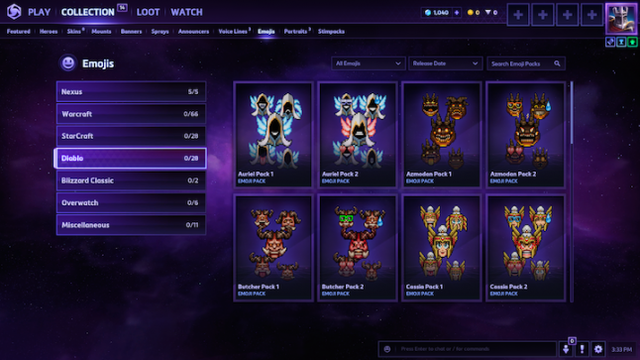Trending
Opinion: How will Project 2025 impact game developers?
The Heritage Foundation's manifesto for the possible next administration could do great harm to many, including large portions of the game development community.
Blizzard's 2.0 update for Heroes of the Storm is all about progression. We talk to game director Alan Dabiri to find out why.

Normally, when you think of a game update that merits the phrase “2.0,” you’re thinking of a somewhat significant core content update right? New characters, new mechanics, big new ideas, etc. But Blizzard made a curious-yet-significant move today when it announced that Heroes of the Storm’s 2.0 update will be focused primarily on the external progression systems, not major updates to Heroes of the Storm matches themselves.
Before you wonder how an update like this can land without affecting core gameplay systems, don’t worry, there are still new characters on the way like the Diablo 2 hero Cassia. But when Blizzard invited us down for a look at their new update, much of their presentation was focused on the loot crates, crafting systems, and new leveling methods that link time spent with individual Heroes to a player’s overall level.
Heroes of the Storm game director Alan Dabiri says that’s because Blizzard sees this work as a milestone for everything the company has been working on in its regular updates since the game’s release, which makes it pretty clear that even though a strongly-developed MOBA base is necessary for the success of Heroes of the Storm, its survival, and the survival of other MOBAS, depends on a progression system that lives on outside individual matches (especially if it wants to improve its esports fanbase).
Looking at Heroes of the Storm’s newest additions, it’s worth paying attention to the timely arrival of loot crates and a revamped leveling system that places those crates at different milestones as a reward. Hearthstone and Overwatch already benefit from this crafting system, but while presenting to press and streamers, lead game designer Travis McGeathy that there were some special considerations in implementing these systems that were necessary for the MOBA format.
First, loot chests not only contain purchasable heroes and their different custom skins, but also currency and resources that can be used to craft individual items that players desire. In tuning these boxes, McGeathy actually is slightly more transparent about the odds of getting high-quality items than other Blizzard teams have been. He says these boxes have a randomness modifier to try and minimize duplicates, and will include a reroll mechanic to let players re-open unfavorable loot crates.
“Loot crates can be fun when you’re getting good stuff, but you have bad luck it can suck,” he puts bluntly.

After laying out some of the new items that will be in the loot chests (including emoji packs, like the ones on the left, which are really cute and everyone should put these in their games now), McGeathy shows a chart explaining how the game’s level curve will be adjusted, reducing the amount of hours needed for more experienced players to earn new levels, and placing loot crates—including variations of loot crates—along the way. It’s a system that seems more tuned for the way live games have evolved, and one that gives players more answers for the eternal question “why should I keep playing” beyond “to improve your own skill.”
To be clear, many of the ideas for loot crates, crafting, and rewards exist in other online games, but keeping an eye on Blizzard’s structure in Heroes of the Storm may be worthwhile for system designers because it’s been tuned with community response and implemented as a capstone on two years’ worth of development, not slowly integrated and tuned as it has been in other games.
For comparison, when League of Legends implemented loot crates, it did so under the shadow of the fact that most of their core playerbase was at the game’s maximum player level, which meant it couldn’t use its leveling system as kind of a global progress tracker with clear rewards the way Blizzard can here.
Dabiri says if they’d tried to follow that model, and release the various components of this update along its traditional live update status, it wouldn’t have been as useful. “I don’t know that while those progression changes would have been would have been a welcome addition and a welcome change, getting those frequent rewards as you level up, that’s the other side of the coin,” he explains. “They just naturally fit together.”

Heroes of the Storm has enjoyed some unusually robust success in the eSports team thanks to a vibrant streaming community, a Blizzard-backed tournament system, and screen time on ESPN with Heroes of the Dorm. So it was slightly unusual to actually not hear the word “eSports” mentioned that often during the press event this week (especially to a crowd that included so many competitive players).
Dabiri didn’t quite come out and say nothing in this update was “esports-centric” (there’s not any key updates designed only for tournaments or livestreaming) but he offered some thoughts about why is 2.0 update would benefit the the sports function of Heroes of the Storm.
“I think the systems going in are going to be engaging for players, and as a result, people will play more, and that’ll support eSports as well,” he mused. Gameplay retention would obviously benefit Heroes as much as it would any other game, but the tool is there (if unused) to also use loot crates now as a part of some reward structure for game elements related to tournaments. “It could be another reward mechanism, that we offer to engage with [people who watch eSports.]”
Blizzard does already create exclusive in-game rewards for some of its events, so it’ll be worth monitoring if this becomes part of their monetization strategy in the near future.
You May Also Like